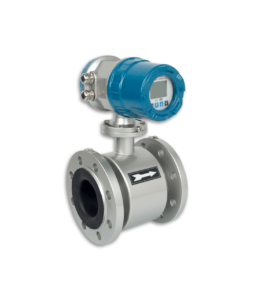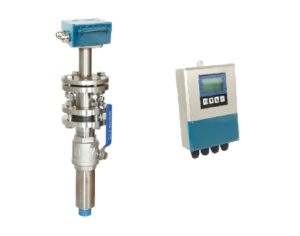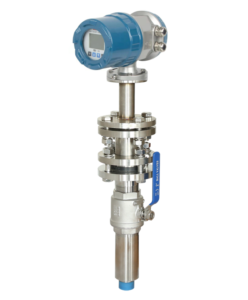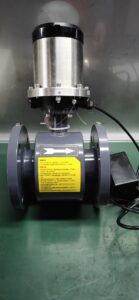1.The liquid contains gas
The dissolved gas in the liquid will not affect the flow measurement, and the free gas (that is, air bubbles) will affect the measurement and may cause malfunctions. There are three sources of free gas in the liquid: ① the air in the pipeline is not exhausted; ② inhaled from outside the piping system: ③dissolved gas conversion. The latter is caused by changes in the temperature and pressure of the liquid in the tube.
In the process industry, the pipeline liquid pressure/temperature often fluctuates. When the liquid pressure decreases or the temperature rises, the dissolved gas turns into free bubbles. Air may be transformed into bubbles; the liquid above room temperature will gradually cool and shrink in the closed pipes at both ends, forming a partial vacuum, dissolving air, or vaporized vapor to form bubbles. The bubble formed in this way will often show output shaking in the initial stage of the process restart, and it will become normal after running for a period of time. When the opening of the control valve is very small, volatile liquids sometimes vaporize and form bubbles.

2.Liquid contains a solid phase
The liquid contains solids such as powder, particles, or fibers, which may cause malfunctions:
①Pulse wave block sound;
②Four electrode surface pollution;
③The conductive deposition layer or insulating deposition layer covers the electric board into the village;
④The village is worn or deposited, changing the circulation area.
Case study:
Short circuit effect of the conductive deposited layer
The electromagnetic flow sensor measuring tube is insulated. If conductive material is deposited on the surface of the lining, the flow signal will be short-circuited and the meter will fail. Since the conductive material is gradually deposited, this type of fault usually does not appear during the commissioning period, and will only be revealed after a period of operation.
A DN80mm meter was used to measure and control the flow of saturated salt electrolytes to obtain the best cutting efficiency on the electrolytic cutting process test device in the tool shop of a diesel engine factory. At first, the meter was operating normally. After two months of intermittent use, I felt that the flow rate display value was getting smaller and smaller until the flow rate signal was close to zero. The on-site inspection found that a thin layer of yellow rust was deposited on the surface of the insulating layer. After wiping and cleaning, the meter worked normally. The yellow rust layer is caused by the deposition of a large amount of iron oxide in the electrolyte.
This case is a fault during operation. Although it is not common, if the ferrous metal pipeline is severely corroded and the rust layer is deposited, this short-circuit effect will also occur. When it starts to run normally, and the flow display becomes smaller and smaller as time goes by, the possibility of such failures should be analyzed.
Case study:
A water plant in Shanghai uses a rectangular pipe to divert water from the upper reaches of the Huangpu River more than 30 kilometers away, and then uses two DN1600mm round pipes to pump raw water into the plant. Two DN1600m electromagnetic flow meters are used to measure the water volume. It was opened in 1991 and used normally, but it was felt that the metering decreased in 1993. After inspection, the cause of the failure of the opening part of the meter was eliminated. Check the asymmetry of the resistance value of the two electrodes of the flow sensor to the ground, and analyze the possibility of failure of the flow sensor. The hidden part cannot be checked because the current cannot be cut off.
It was only in April 1997 that people had the opportunity to enter the pipeline to check the internal condition of the flow sensor measuring tube. The thickest part of the confluent silt on the inner wall was more than 10mm, and the electrode surface was also covered by a silt deposit layer, which was flush with the surrounding silt layer. After scrubbing with a shovel, the operation of the instrument returns to normal. Therefore, it is confirmed that the cause of the failure is caused by the sludge deposited on the internal pipe wall.
This example reminds people that silt will always be deposited on the inner wall of the flow meter channel for raw water metering. Whether it affects the measurement is only the length of time. In this example, the water quality conditions have been running for 3 years and the flow value has been reduced. For this reason, the electromagnetic flowmeter for measuring river raw water must be cleaned regularly. Other flowmeters such as ultrasonic flowmeters and venturi tube flowmeters also have the problem of sedimentation to reduce the flow area and affect the measurement accuracy. The DN1600mm tube deposits 10mm or the value changes by 1.2%-2.5%. At the same time, when designing the process, it is necessary to consider countermeasures against the impact of long-term operation of sedimentary sludge, such as increasing the flow rate at the measurement location to extend the cleaning cycle; preset inspection holes into the pipe for cleaning. This example is a common fault during runtime
3.Uneven conductivity
In the proportioning process, the liquid is often injected into the liquid, and the injection liquid is often added by a reciprocating pump. If the conductivity of the injection liquid is different from that of the main liquid, and the mixed liquid has not been evenly mixed. If the electromagnetic flow sensor is installed downstream, the output of the meter will sway due to a sharp change in conductivity, although the liquid conductivity is greater than the threshold and the slow change will not affect the normal measurement of the electromagnetic flow. This phenomenon often occurs in the process of adding a coagulant to the raw water of water treatment engineering.
4.Improper matching with the material of the liquid contact parts
There are electrodes and grounding rings that cause improper matching with the material of the liquid contact. In addition to the problem of corrosion resistance, improper matching is mainly the surface effect of the electrode.
Surface effects are:
① chemical reaction (passivation film formed on the surface, etc.);
②Electrochemistry and polarization phenomena (generating electric potential);
③The role of catalyst (aerosol generated on the surface of the electrode, etc.). The grounding ring also has these effects, but the degree of influence is smaller.
Case study:
A chemical (smelting) plant in Shanghai used more than 20 Hastelloy B-electrode electromagnetic flowmeters to measure a high-concentration hydrochloric acid solution, and the output signal was unstable. The on-site inspection confirmed that the instrument was normal, and other interference causes that would cause output shaking was also eliminated. At this time, many other users use Hastelloy B electrode meters to measure hydrochloric acid. They are running well. When analyzing whether the cause of the failure may be caused by the difference in hydrochloric acid concentration, there is no experience in the effect of hydrochloric acid concentration on the electrode surface. For this reason, the instrument manufacturer and the user unit went to the chemical plant to do a real flow test to change the concentration of hydrochloric acid. The concentration of hydrochloric acid gradually increases, and the output of the meter is stable when the concentration is low
When the concentration increases to 15% ~ 20%, the output of the meter starts to shake, and when the concentration reaches 25%, the output shakes up to 20%. After switching to a group electrode electromagnetic flowmeter, it runs normally.



